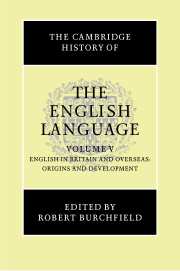Book contents
- Frontmatter
- 1 Introduction
- PART I Regional varieties of English in Great Britain and Ireland
- 2 ENGLISH IN SCOTLAND
- 3 ENGLISH IN WALES
- 4 ENGLISH IN IRELAND
- 5 THE DIALECTS OF ENGLAND SINCE 1776
- PART II English overseas
- Glossary of linguistic terms
- Bibliography
- Index
- THE CAMBRIDGE HISTORY OF THE ENGLISH LANGUAGE
- Map 7.1 Movements of English/Creole speakers in the seventeenth century
- Map 7.2 Movements of English/Creole speakers after 1700
- References
5 - THE DIALECTS OF ENGLAND SINCE 1776
from PART I - Regional varieties of English in Great Britain and Ireland
Published online by Cambridge University Press: 28 March 2008
- Frontmatter
- 1 Introduction
- PART I Regional varieties of English in Great Britain and Ireland
- 2 ENGLISH IN SCOTLAND
- 3 ENGLISH IN WALES
- 4 ENGLISH IN IRELAND
- 5 THE DIALECTS OF ENGLAND SINCE 1776
- PART II English overseas
- Glossary of linguistic terms
- Bibliography
- Index
- THE CAMBRIDGE HISTORY OF THE ENGLISH LANGUAGE
- Map 7.1 Movements of English/Creole speakers in the seventeenth century
- Map 7.2 Movements of English/Creole speakers after 1700
- References
Summary
Some early observations
Our knowledge of the dialects of England from about 1500 till the first systematic description towards the end of the nineteenth century comes from a variety of sources: occasional regional spellings that continued into written documents, comments (usually derogatory) by the orthoepists, grammarians and lexicographers, glossaries of ‘provincial words', occasional references to local speech in travel literature, fictional texts written to illustrate regional speech, and the use of dialect in literary works. Dialect in fiction is particularly interesting because it places regional speech in a social context. For instance, from Fielding's Tom Jones we gather that in the eighteenth century there were members of the landed gentry in the south-west who voiced their initial fricatives, used un for him, thee for thou and dropped the second person singular subject in questions, as in Dost fancy I don't know it as well as thee; they had the third person singular present-tense marker -th with auxiliaries, but -s with main verbs. What we do not find is the earlier common southern and south-western use of ich for ‘I', and we are left in the dark as to whether this form had become obsolete in the type of language described, was not used by the type of people the writer had in mind, or was simply not chosen by the writer to give local colouring. Generally speaking, the picture that emerges from the early evidence is patchy, difficult to interpret and open to conjecture.
- Type
- Chapter
- Information
- The Cambridge History of the English Language , pp. 197 - 274Publisher: Cambridge University PressPrint publication year: 1994
References
- 40
- Cited by

